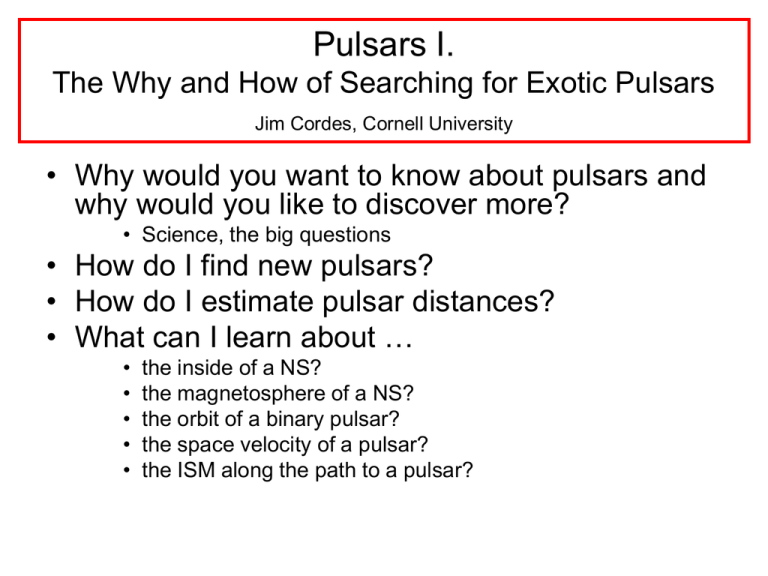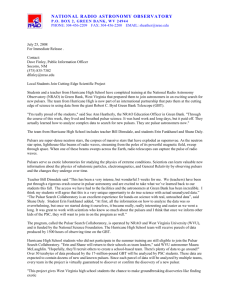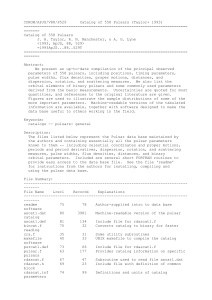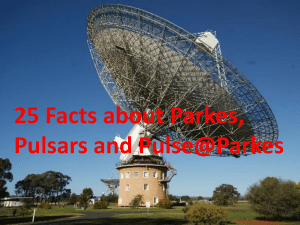single-dish.school.2005 - Cornell - Astronomy
advertisement

Pulsars I. The Why and How of Searching for Exotic Pulsars Jim Cordes, Cornell University • Why would you want to know about pulsars and why would you like to discover more? • Science, the big questions • How do I find new pulsars? • How do I estimate pulsar distances? • What can I learn about … • • • • • the inside of a NS? the magnetosphere of a NS? the orbit of a binary pulsar? the space velocity of a pulsar? the ISM along the path to a pulsar? Pulsars I. The Why and How of Searching for Exotic Pulsars Jim Cordes, Cornell University • Why would you want to know about pulsars and why would you like to discover more? • Science, the big questions • How do I find new pulsars? • How do I estimate pulsar distances? • What can I learn about … • • • • • the inside of a NS? the magnetosphere of a NS? the orbit of a binary pulsar? the space velocity of a pulsar? the ISM along the path to a pulsar? Pulsars I. The Why and How of Searching for Exotic Pulsars Jim Cordes, Cornell University • The forefront of neutron star science • • • • Extreme states of matter Gravitational laboratories Probing core collapse supernovae Galactic structure • Issues in pulsar survey optimization • • • • Dedispersion Periodicity searches Single pulse searches Simulations of pulsar surveys • ALFA: A massive pulsar survey at Arecibo • SKA: toward a full Galactic census of pulsars Pulsars… • Embody physics of the EXTREME – surface speed ~0.1c – 10x nuclear density in center – some have B > Bq = 4.4 x 1013 G – Voltage drops ~ 1012 volts – FEM = 109Fg = 109 x 1011FgEarth – Tsurf ~ 106 K • Relativistic plasma physics in action ( ~ 106) • Probes of turbulent and magnetized ISM • Precision tools, e.g. - Period of B1937+21 (the fastest millisecond pulsar) P = 0.00155780649243270.0000000000000004 s Orbital eccentricity of J1012+5307: e<0.0000008 • Laboratories for extreme states of matter and as clocks for probing space-time and Galactic material Neutron Star Astrophysics Surface quantities: B 1012 Gauss gNS 1011 g FEM 109 gNS mp 1012 volts Pulsar Populations: diagram • Canonical • Millisecond pulsars (MSPs) • P ~ 1.5 – 20ms • B ~ 108 – 109 ms • High field • P~5–8s • B ~ few x 1013 G • Braking index n: • • n=3 magnetic dipole radiation log Period derivative (s s-1) • P~ 20ms – 5s • B ~ 1012±1 G • Death line • Strong selection effects Period (sec) Pulsar Populations: diagram • Canonical • Millisecond pulsars (MSPs) • P ~ 1.5 – 20ms • B ~ 108 – 109 ms • High field • P~5–8s • B ~ few x 1013 G • Braking index n: • • n=3 magnetic dipole radiation log Period derivative (s s-1) • P~ 20ms – 5s • B ~ 1012±1 G • Death line • Strong selection effects Period (sec) Spindown Spinup Quarks to Cosmos: Relevant Questions • Did Einstein have the last word on Gravity? • How do cosmic accelerators work and what are they accelerating? • What are the new states of matter at exceedingly high density and temperature? • Is a new theory of light and matter needed at the highest energies? First Double Pulsar: J0737-3939 Lyne et al.(2004) • Pb=2.4 hrs, d/dt=17 deg/yr • MA=1.337(5)M, MB=1.250(5)M Now to 0.1% Testing GR: s obs 1.000 0.002 exp s Kramer et al.(2004) What are the Big Questions? • Formation and Evolution: • What determines if a NS is born as a magnetar vs a canonical pulsar? • How fast do NS spin at birth? • How fast can recycled pulsars spin? • What is the role of instabilities and gravitational radiation in determining the spin state? • How do momentum thrusts during core collapse affect the resulting spin state and translational motion of the NS? • What processes determine the high space velocities of NS? » » » » Neutrino emission Matter rocket effects Electromagnetic rocket effect (Harrison-Tademaru) Gravitational-wave rocket effect • Are orbital spiral-in events at all related to high-energy bursts? (GRBs? Other transients?) What are the Big Questions? • NS Structure: • • • • Are neutron stars really neutron stars? What comprises the core of a NS? What is the mass distribution of NS? In what regions are the neutrons in a superfluid state? • How large are interior magnetic fields? • Magnetosphere and Emission Physics: • What QED processes are relevant for electromagnetic emissions? What are the Big Questions? • NS as Laboratories: • Can departures from General Relativity be identified in the orbits of compact binary pulsars? • Does the Strong-Equivalence Principle hold to high precision in pulsars with WD or BH companions? • NS as Gravitational Wave Detectors: • Use pulsars to detect long-period gravitational waves » Early universe » Mergers of supermassive black holes » Topological defects (cosmic strings) • Pulsars as Probes of Galactic Structure • What kind of spiral structure does the Galaxy have? • What is the nature of interstellar turbulence? Fulfilling the Promise of NS Physics and Astrophysics • • • • Find more pulsars Time them with maximal precision Phase-resolved polarimetry VLBI them to get high astrometric precision Step 1: conduct surveys that optimize the detection of faint, pulsed emission that is dispersed and that may or may not be periodic. Currently about 1700 pulsars known Galactic birth rate ~ 1/100 yr 10 Myr lifetime for canonical pulsars 105 active pulsars 20% beaming fraction 2104 detectable pulsars + 10% more MSPs + NS-NS, NS-BH etc. Arecibo + SKA Surveys Pulsar Search Domains Region/Direction Kind of Pulsar Telescope Arecibo, Effelsburg, GBT, Jodrell, Parkes, WSRT Galactic Plane Young pulsars (< 1 Myr) Galactic Center Young, recycled, GBT, SKA binary, circum-SgrA* Moderate Galactic latitudes MSPs, binary, runaway Globular clusters MSPs, binary Local Group Galaxies Young (probably) Giant pulses Arecibo, GBT, Parkes Arecibo, GBT, Parkes Arecibo, GBT, SKA A Single Dispersed Pulse from the Crab Pulsar Arecibo WAPP S ~ 160 x Crab Nebula ~ 200 kJy Detectable to ~ 1.5 Mpc with Arecibo Refractive indices for cold, magnetized plasma 2 3 nl,r ~ 1 - p2 / 2 2 2 + p B >> p ~ 2 kHz >> B ~ 3 Hz Group velocity group delay = (time of arrival) t = t DM ± t RM birefringence t DM = 4.15 ms DM -2 t RM = 0.18 ns RM -3 Dispersion Measure DM = ds ne pc cm-3 Rotation Measure RM = 0.81 ds ne B rad m-2 Basic data unit = a dynamic spectrum Fast-dump spectrometers: Frequency 64 to 1024 channels 106 – 108 samples x 64 s P time • Analog filter banks • Correlators • FFT (hardware) • FFT (software) • Polyphase filter bank E.g. WAPP, GBT correlator + spigot card, new PALFA correlator Frequency P Time Interstellar Scintillation RFI Astrophysical effects are typically buried in noise and RFI Frequency P Time New Pulsars Periodicity Search (FFT) Single-pulse search (matched filtering) Known Pulsars Arrival time Monitoring Polarization Analysis Scintillation Studies Frequency P Time New Pulsars Periodicity Search (FFT) Single-pulse search (matched filtering) Known Pulsars Arrival time Monitoring Polarization Analysis Scintillation Studies Issues In Pulsar Survey Optimization • Combine the signal over time and frequency while maximizing S/N through matched filtering: • Dedispersion: sum over frequency while removing the dispersive time delays • Single pulses: match the shape and width of the pulse • Periodic pulses: match the period as well as the pulse shape and width • Orbital motion: match the change in pulse arrival times related to the changing Doppler effect Single-pulse searches: Search vs. (DM, W) Periodicity searches: Search vs. (DM, W, P, [orbital parameters]) Dedispersion Two methods: Coherent: • operates on the voltage proportional to the electric field accepted by the antenna, feed and receiver • computationally intensive because it requires sampling at the rate of the total bandwidth • “exact” Post-detection: • operates on intensity = |voltage|2 • computationally less demanding • an approximation Basic data unit = a dynamic spectrum Fast-dump spectrometers: Frequency 64 to 1024 channels 106 – 108 samples x 64 s P time • Analog filter banks • Correlators • FFT (hardware) • FFT (software) • Polyphase filter bank E.g. WAPP, GBT correlator + spigot card, new PALFA correlator Dispersed Pulse t = 8.3 s DM -3 Coherently dedispersed pulse Coherent Dedispersion pioneered by Tim Hankins (1971) Dispersion delays in the time domain represent a phase perturbation of the electric field in the Fourier domain: Coherent dedispersion involves multiplication of Fourier amplitudes by the inverse function, For the non-uniform ISM, we have which is known to high precision for known pulsars. The algorithm consists of Application requires very fast sampling to achieve usable bandwidths. Coherent Dedispersion pioneered by Tim Hankins (1971) Coherent dedispersion works by explicit deconvolution: Comments and Caveats: • Software implementation with FFTs to accomplish deconvolution (Hankins 1971) • Hardware implementations: real-time FIR filters (e.g. Backer et al. 1990s-present) • Resulting time resolution: 1 / (total bandwidth) • Requires sampling at Nyquist rate of 2 samples bandwidth Computationally demanding • Actual time resolution often determined by interstellar scattering (multipath) • Most useful for low-DM pulsars and/or high-frequency observations Micropulses coherently dedispersed (Hankins1971) Nanostructure in Crab pulsar giant pulses Postdetection Dedispersion: Sum intensity over frequency after correcting for dispersion delay Interstellar scattering from electron density variations • Pulsar velocities >> ISM, observer velocities • Scattering is strong for frequencies < 5 GHz • Electron density irregularities exist on scales from ~ 100’s km to Galactic scales Pulse broadening from interstellar scattering: Arecibo WAPP data, Bhat et al 2004 Frequency Frequency Dedispersion at a single known DM time time I(t) time DM Frequency Dedispersion over a set of DMs time time Single pulse searches Giant pulses from M33 Arecibo observations (Mclaughlin & Cordes 2003) A pulsar found through its singlepulse emission, not its periodicity (c.f. Crab giant pulses). Algorithm: matched filtering in the DM-t plane. ALFA’s 7 beams provide powerful discrimination between celestial and RFI transients DM Frequency Pulsar Periodicity Search time time FFT each DM’s time series |FFT(f)| 1/P 2/P 3/P Harmonic Sum The FFT of periodic pulses is a series of spikes (harmonics) separated by 1/P. To improve S/N, sum harmonics. This procedure is an approximation to true matched filtering, which would give optimal S/N. Sum how many harmonics? The answer depends on the pulse “duty cycle” = (pulse width / P) (unknown a priori) need to use trial values of Nh: Sum over harmonics Maximize h() with respect to Nh to identify candidate pulsars. Noise and RFI conspire to yield spurious candidates. Need a high threshold. How high? Minimum detectable flux density for a single harmonic: Minimum detectable flux density for harmonic sum: Example Time Series and Power Spectrum for a recent PALFA discovery (follow-up data set shown) DM = 0 pc cm-3 Time Series Where is the pulsar? DM = 217 pc cm-3 Example Time Series and Power Spectrum for a recent PALFA discovery (follow-up data set shown) DM = 0 pc cm-3 Time Series Here is the pulsar DM = 217 pc cm-3 Pulse shape Effects that broaden pulses reduce the harmonic sum, which is bad FFT Harmonic sum Survey Selection Against Binaries NS-NS binary Pulse shape Phase perturbation FFT harmonics Harmonic Sum Dealing With Orbital Motion Orbital acceleration yields a time-dependent period, potentially destroying the power of the straightforward FFT + HS. • Long-period binaries: T = data span length << Porb • Do nothing different • Intermediate-period orbits: T < 0.1 Porb • Acceleration search: compensate the time domain or match filter in the frequency domain according to an acceleration parameter • Adds another search parameter: DM, P, W, a • Very short period orbits: T > Porb (potentially >> Porb) • Do conventional FFT but search for orbital sidebands Hardware for Pulsar Science Predetection Samplers and Analyzers: • ASP, GASP (Arecibo & Green Bank) » Real-time dedispersion and folding • New Mexico Tech burst sampler » Off-line dedispersion • Generic baseband samplers (c.f. radar samplers) Postdetection Samplers: • WAPP (Arecibo), SPIGOT (GBT) (correlators) » Searching and timing machines • New PALFA spectrometer (polyphase filter bank) » Primarily a search machine Software for Pulsar Searching • • • • • • Many proprietary packages Sigproc/Seek package PRESTO Cornell Code Berkeley Code PALFA: the PALFA Consortium is testing and consolidating codes to produce a new “standard” pulsar search package The power of ALFA: I(, t, j) j=1,6 Massive ALFA Pulsar Surveys 103 new pulsars • • • Reach edge of Galactic population for much of pulsar luminosity function High sensitivity to millisecond pulsars Dmax = 2 to 3 times greater than for Parkes MB Sensitivity to transient sources Commensal SETI Search (Wertheimer UCB) Data management: • • • • Keep all raw data (~ 1 Petabyte after 5 years) at the Cornell Theory Center (CISE grant: $1.8M) Database of raw data, data products, end products Web based tools for Linux-Windows interface (mysql ServerSql) VO linkage (in future) ALFA pulsar surveys will be the deepest surveys of the Galaxy until the SKA is built: Blue: known pulsars (prior to Parkes MB) Red: Parkes MB Green: PALFA simulated pulsars Example of the SKA as a Pulsar-Search Machine ~104 pulsar detections with the SKA (assuming all-sky capability) • rare NS-NS, NS-BH binaries for probing strong-field gravity • millisecond pulsars < 1.5 ms • MSPs suitable for gravitational wave detection • Galactic tomography of electron density and magnetic field • Spiral-arm definition Blue points: SKA simulation Black points: known pulsars SKA: What is It? • • • • An array telescope that combines complete sampling of the time, frequency and spatial domains with a 20-100 increase in collecting area (~ 1 km2) over existing telescopes. Frequency range 0.1 – 25 GHz (nominal) Limited gains from reducing receiver noise or increasing bandwidth once the EVLA is finished Innovative design needed to reduce cost • • • • An international project from the start International funding • • Executive, engineering, science, siting, simulation groups Timeline for construction extends to 2020 • • • Cost goal ~ € 1 billion 17-country international consortium • • 106 meter2 ~ €1,000 per meter2 c.f. existing arrays ~ €10,000 per meter2 Can be phased for different frequency ranges Can do science as you go The existing US radio astronomy portfolio is the foundation on which to build the SKA 20 50 Pulsar Distances Type Number Parallaxes: Interferometry timing optical Associations SNRs false associations GCs 16 LMC,SMC HI absorption DM + ne model 1 mas @ 1 kpc 1.6 s @ 1 kpc HST, point spread function ~13 ~5 ~1 8 Comments ~8 74 all radio pulsars (~ 1400) bright pulsars, galactic rotation model ISM perturbations NE2001: Galactic Distribution of Free Electrons + Fluctuations Paper I = the model (astro-ph/0207156) Paper II = methodology & particular lines of sight (astroph/0301598) Based on ~ 1500 lines of sight to pulsars and extragalactic objects Code + driver files + papers: www.astro.cornell.edu/~cordes/NE2001 But … if you want a good distance, measure the parallax ! e.g. Arecibo + GBT + VLA + VLBA will be a powerful parallax and proper motion machine Very Long Baseline Array PSR B0919+06 S. Chatterjee et al. (2001) = 88.5 0.13 mas/yr = 0.83 0.13 mas D = 1.2kpc V = 505 km/s Proper motion and parallax using the VLBA (Brisken et al. 2001) PSR B1929+10 Chatterjee et al. 2003




